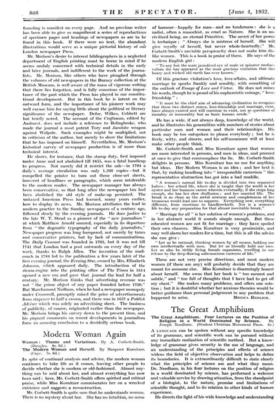The London Press
IF some well-endowed scholar with boundless leisure and infinite patience ever attempts to write a full history of English journalism, he will find Mr. Morison's Cambridge lectures on the newspapers printed in London from 1622 to the present day of very considerable service. This handsome volume-- the finest by far in the scanty literature of the subject —is. concerned mainly with the typography and make-up of the, countless sheets that have appeared in the past three centuries. No one has studied this aspect of the matter so thoroughly as Mr. Morison, whose profound knOwledge of types and type.
founding is manifest on every page. And no previous writer has been able to give so magnificent a series of reproductions of specimen pages and headings of newspapers as are to be found in this book. If there were no text, the abundant illustrations would serve as a unique pictorial history of our London newspaper Press.
Mr. Morison's desire to interest bibliographers in a neglected department of English printing must be borne in mind if he seems unduly concerned with technical details in the early and later journals, and indifferent to the work of the journa- lists. Mr. Morison, like others who have ploughed through the volumes of old newspapers in the Burney collection at the British Museum, is well aware of the mass of vigorous writing that there lies forgotten, and is fully conscious of the impor- tance of the part which the Press has played in our constitu- tional development. But in this book he is intent on the outward form, and the importance of his pioneer work may well excuse him for saying little about the political or literary significance of the newspaper. Defoe, Wilkes, Cobbett are but briefly noted. The account of the Craftsman, edited by Amhurst, does not include a reference to Bolingbroke, who made the journal a most potent Tory and Jacobite weapon against Walpole. Such examples might be multiplied, not in criticism of the author, but merely to show the limitations that he has imposed on himself. Nevertheless, Mr. Morison's historical survey of newspaper production is of more than technical interest.
He shows, for instance, that the stamp duty, first imposed under Anne and not abolished till 1855, was a fatal handicap to progress. Not merely did it restrict the sale—in 1794 a daily's average circulation was only 1,500 copies—but it compelled the printer to turn out those close-set sheets, innocent of headlines or paragraphs, which seem intolerable to the modern reader. The newspaper manager has always been conservative, so that long after the newspaper tax had been abolished the old style of make-up persisted. The untaxed American Press had learned, many years earlier, how to display its news. Mr. Morison attributes the lead in modern practice to the Sunday newspapers of a century ago, followed slowly by the evening journals. He does justice to the late W. T. Stead as a pioneer of the " new journalism " at which Matthew Arnold sneered, especially in its departure from the dogmatic typography of the daily journalists." Newspaper progress was long hampered, not merely by taxes and conservative printers, but by lack of communications. The Daily Courant was founded in 1702, but it was not till 1741 that London had a post outwards on every day of the week, thanks to Ralph Allen. The invention of the mail- coach in 1784 led to the publication a few years later of the first evening journal, the Evening Star, owned by Mrs. Elizabeth Johnson, which appeared daily. The introduction of the steam-engine into the printing office of The Times in 1814 opened a new era and gave that journal the lead for half a century. Mr. Morison thinks that advertising revenue was not " the prime object of any paper founded before 1730." But Marehamont Nedham, when he had a newspaper monopoly under Cromwell, promptly raised the price of advertisements from sixpence to half a crown, and there was in 1657 a Pubtick Adviser which was solely an advertising sheet. The business of publicity, of course, originated earlier than the newspaper. Mr. Morison brings his survey down to the present time, and his piquant comments on recent developments in journalism form an amusing conclusion to a decidedly serious book.





































 Previous page
Previous page